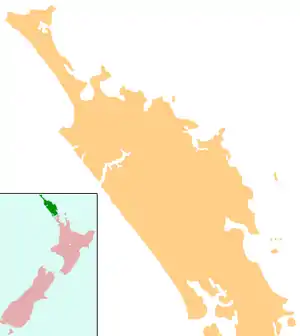Ruawai
Ruawai is a small town located 30 km south of Dargaville in Northland, New Zealand.
Ruawai | |
|---|---|
 Ruawai | |
| Coordinates: 36°8′11″S 174°1′26″E | |
| Country | New Zealand |
| Region | Northland Region |
| District | Kaipara District |
| Population (2018) | |
| • Total | 471 |
The name literally translated from Maori means 'two waters' referring to the nearby Northern Wairoa River and Kaipara Harbour. The township primarily serves the outlying farming area which consists mainly of cattle farming and kumara growing and the town declared itself as the Kumara capital of the world.[1]
The local Naumai Marae and Ngā Uri o te Kotahitanga meeting house is a traditional meeting place for Ngāti Whātua and Te Uri o Hau.[2][3]
Demographics
| Year | Pop. | ±% p.a. |
|---|---|---|
| 2006 | 2,235 | — |
| 2013 | 2,289 | +0.34% |
| 2018 | 2,436 | +1.25% |
| Source: [4] | ||
The statistical area of Ruawai-Matakohe, which at 530 square kilometres is much larger than this town, had a population of 2,436 at the 2018 New Zealand census, an increase of 147 people (6.4%) since the 2013 census, and an increase of 201 people (9.0%) since the 2006 census. There were 948 households. There were 1,281 males and 1,152 females, giving a sex ratio of 1.11 males per female. Of the total population, 447 people (18.3%) were aged up to 15 years, 345 (14.2%) were 15 to 29, 1,164 (47.8%) were 30 to 64, and 480 (19.7%) were 65 or older. Figures may not add up to the total due to rounding.
Ethnicities were 85.8% European/Pākehā, 26.2% Māori, 2.5% Pacific peoples, 1.0% Asian, and 1.7% other ethnicities. People may identify with more than one ethnicity.
The percentage of people born overseas was 9.2, compared with 27.1% nationally.
Although some people objected to giving their religion, 53.9% had no religion, 28.9% were Christian, and 5.8% had other religions.
Of those at least 15 years old, 177 (8.9%) people had a bachelor or higher degree, and 594 (29.9%) people had no formal qualifications. The median income was $23,600. The employment status of those at least 15 was that 852 (42.8%) people were employed full-time, 309 (15.5%) were part-time, and 81 (4.1%) were unemployed.[4]
Ruawai town had a population of 471 at the 2018 census, an increase of 39 since 2013. There were 240 males and 231 females. 79.6% identified as European/Pākehā, and 37.6% as Māori.[5]
Education
Ruawai College is a secondary (years 7-13) school with a roll of 156 students as of March 2020.[6][7] Ruawai District High School was established in 1929.[8] In December 1995, Ruawai College installed a 128kbit/s DDS leased line connection that delivered internet services and offered dialup internet with IGRIN billing the service (IGRIN has since purchased by Orcon). The arrangement delivered internet to the rural community where the nearest dialup internet services were a toll call away, as well as giving the school low cost internet. At the time, only a handful of schools nationally had a campus-wide, hard wired internet service.
Ruawai School is a contributing primary (years 1-6) school with a roll of 113 students as of March 2020.[6][9]
Both schools are coeducational.
Notable people
- Lockwood Smith, politician.
- Roy Billing OAM, noted NZ actor, now domiciled in Australia, was brought up in Ruawai where he attended Ruawai High School
References
- "Ruawai Travel Guide". Jasons Travel Media.
- "Te Kāhui Māngai directory". tkm.govt.nz. Te Puni Kōkiri.
- "Māori Maps". maorimaps.com. Te Potiki National Trust.
- "Statistical area 1 dataset for 2018 Census". Statistics New Zealand. March 2020. Ruawai-Matakohe (109400). 2018 Census place summary: Ruawai-Matakohe
- "Age and sex by ethnic group (grouped total response), for census usually resident population counts, 2006, 2013, and 2018 Censuses (urban rural areas)". Statistics New Zealand. Retrieved 20 November 2020.
- "New Zealand Schools Directory". New Zealand Ministry of Education. Retrieved 26 April 2020.
- Education Counts: Ruawai College
- Ryburn, Wayne (1999). Tall Spars, Steamers & Gum. p. 167. ISBN 0-473-06176-7.
- Education Counts: Ruawai School